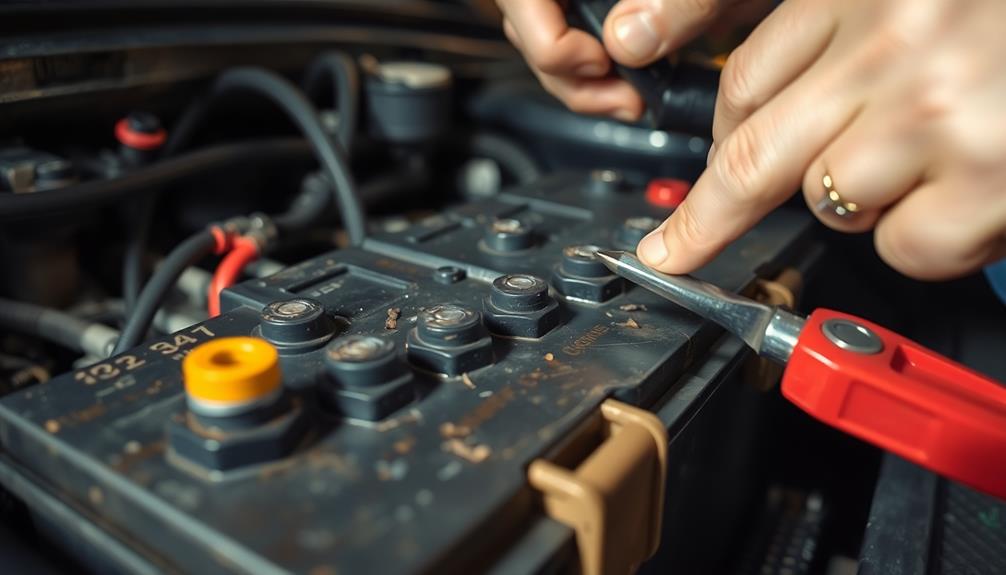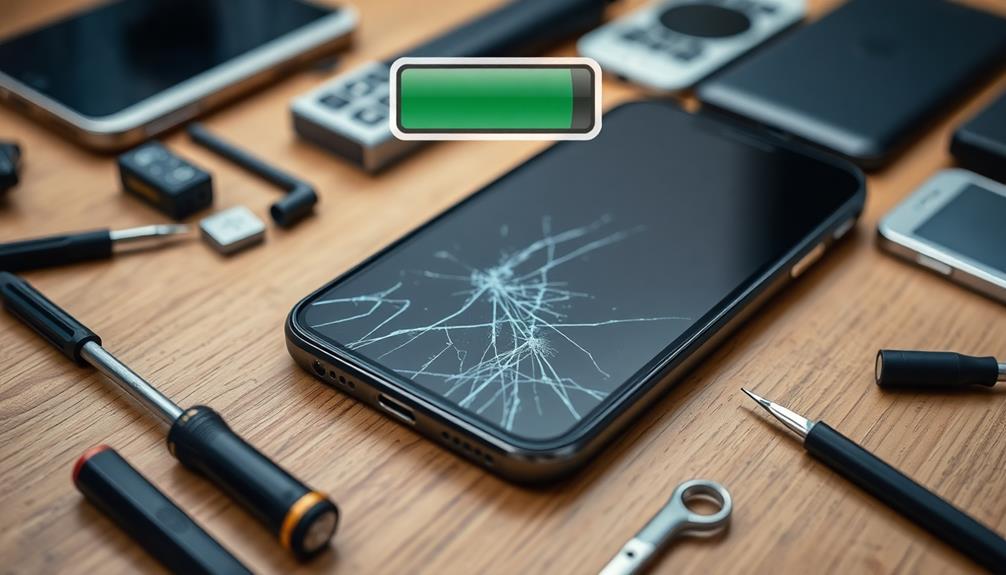Your car's electrical system is essential for your vehicle's performance and safety, so you need to check for warning lights on your dashboard. Flickering lights or warning indicators often signal issues with your battery or alternator. If you notice dashboard lights activating frequently, don't ignore them—they're important alerts about potential electrical failures. Take a moment to inspect battery terminals for corrosion or frayed wiring. If problems persist, using a multimeter can help diagnose deeper issues. Remember, early detection is key to avoiding costly repairs, and there's much more to understand about maintaining your vehicle's electrical system.
Key Takeaways
- Inspect battery terminals for corrosion, as buildup can impede electrical flow and lead to system failure.
- Check for flickering lights, which often indicate a failing alternator or weak battery that requires immediate attention.
- Examine wiring harnesses for any signs of wear, fraying, or damage that could disrupt electrical functionality.
- Monitor dashboard warning lights; frequent illumination suggests broader electrical issues needing professional diagnosis.
- Regularly test the battery and alternator with a multimeter to ensure they are functioning within acceptable voltage ranges.
Importance of the Electrical System

While you mightn't think about it often, your car's electrical system is vital for its overall functionality and safety. This system powers important components like the starter, alternator, lights, and safety features such as airbags and ABS.
When your electrical system is healthy, it enhances your vehicle's performance and reliability, reducing the risk of breakdowns and safety hazards on the road.
Regular maintenance of your electrical system is important. Neglecting issues can lead to costly repairs and compromise your vehicle's lifespan. You should pay attention to common symptoms of electrical failures. For instance, if you notice dim lights or malfunctioning accessories, it might be time to take action.
Frequent battery issues can also indicate underlying problems that need addressing.
Understanding the importance of your electrical system helps you identify potential issues early. If something seems off, don't hesitate to seek professional help.
Timely repairs can maintain peak vehicle functionality, ensuring that your car remains safe and reliable. Keeping your electrical system in top shape is key to enjoying worry-free drives and protecting your investment.
Symptoms of Electrical Issues
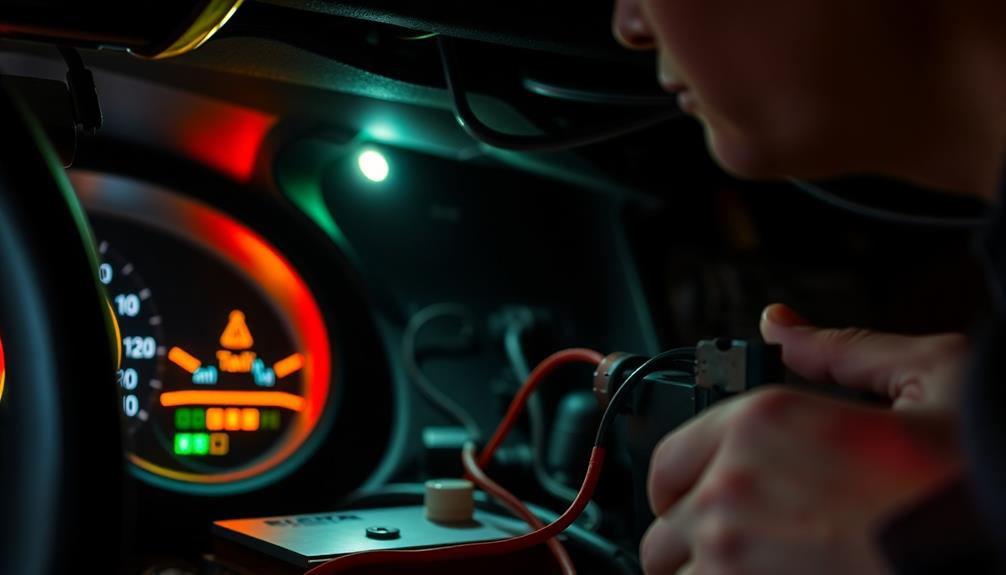
When you notice warning lights on your dashboard, it's a clear sign that something's wrong with your car's electrical system.
Flickering lights can also alert you to potential issues, like a failing alternator or battery.
Paying attention to these symptoms can help you avoid bigger problems down the road.
Warning Light Indicators
Dashboard warning lights serve as your car's way of communicating potential electrical issues that could affect its performance and safety. When you see warning lights illuminate on your dashboard, it's important to pay attention.
For instance, the check engine light often signals faults within the electrical system, ranging from minor to significant problems. Ignoring this light might lead to more extensive damage down the road.
Additionally, the ABS light activation could indicate electrical issues within your brake system, which can seriously compromise vehicle safety. If you notice frequent illumination of warning lights, it may suggest broader electrical issues that require immediate attention. Malfunctioning components can lead to costly repairs if not addressed promptly.
Monitoring these dashboard warning lights is essential for maintaining your vehicle's reliability. They're not just there for decoration; they're critical indicators of your car's health.
Flickering Lights Alert
Flickering lights in your car can signal serious electrical issues that shouldn't be ignored. When you notice flickering headlights, it often indicates a failing alternator or a weak battery. These problems can compromise your vehicle's safety and reliability.
Interior lights that flicker may reveal poor electrical connections or wiring issues, calling for immediate inspection.
Don't overlook dashboard lights losing brightness or flickering; they can point to broader electrical system failures. Regular monitoring of light functionality is essential, as inconsistent performance can disrupt your driving experience and safety.
Common causes of flickering lights include a dying battery, a malfunctioning alternator, or loose wiring connections. Addressing these issues promptly can prevent further damage to the electrical system, ultimately saving you from costly repairs down the line.
Incorporating good car maintenance practices will help you keep your vehicle in top shape. If you notice any flickering lights, take action quickly to diagnose the problem.
Ignoring these symptoms could lead to more severe issues, such as complete electrical failure or even accidents. Stay vigilant and prioritize your car's health!
Visual Inspection Steps
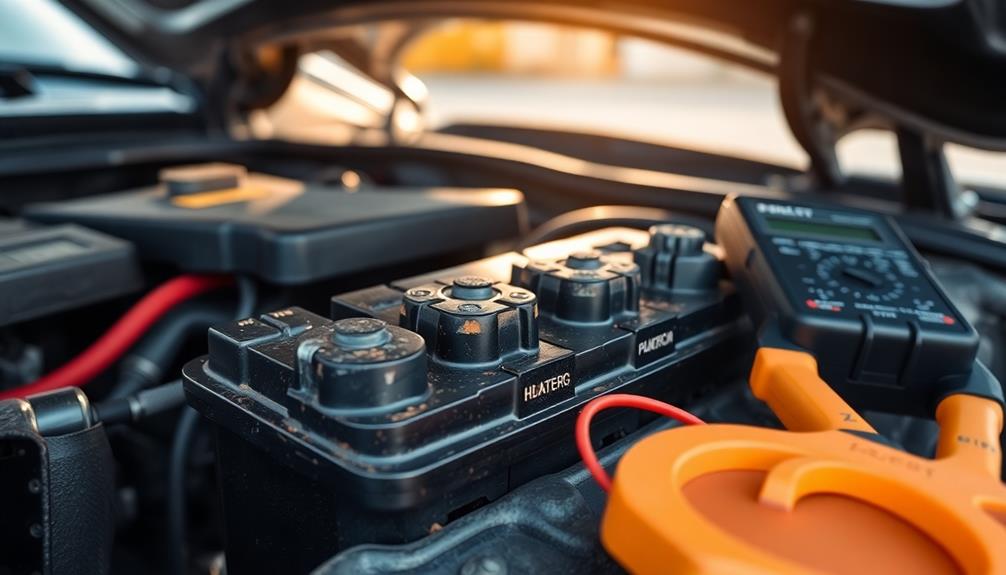
Starting with a thorough visual inspection can help you catch potential issues in your car's electrical system before they escalate. Here are the key steps to follow:
- Battery Check: Inspect your battery terminals for any signs of corrosion. This buildup can impede electrical flow and lead to starting issues. If you notice white, chalky residue, it's time to clean it up.
- Wiring Assessment: Examine all wiring harnesses for wear, fraying, or damage. These issues can cause shorts and disrupt your electrical system. Pay attention to areas where wires might rub against metal components.
- Component Inspection: Look closely at the alternator and starter for any visible damage or leaks. These parts are essential for proper vehicle operation.
Additionally, check the fuse box for any melted fuses, which indicate electrical overload and demand immediate attention.
Lastly, verify that all ground connections are secure and free from corrosion. Poor grounding can lead to various electrical problems, so don't overlook this important step.
Testing With a Multimeter
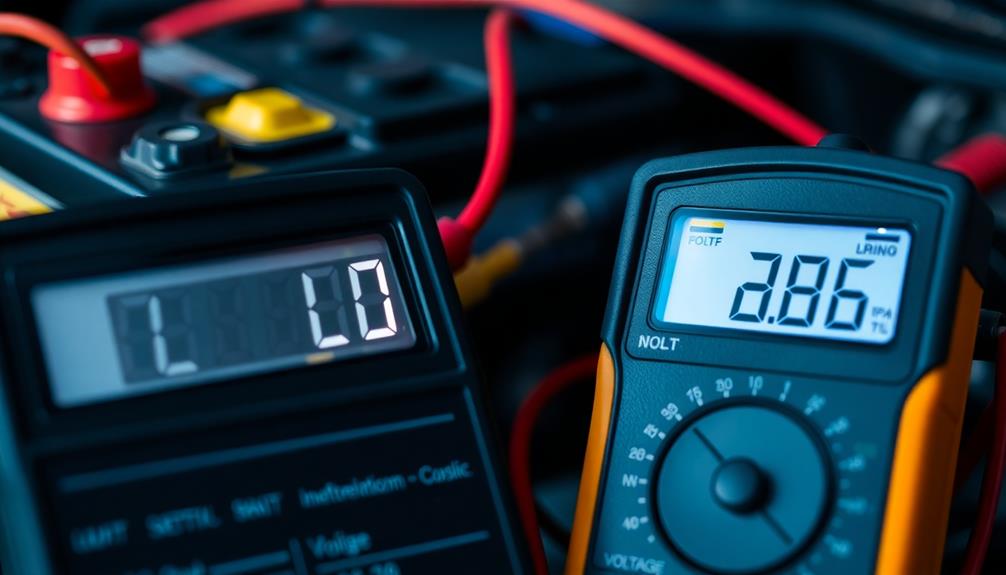
When you're troubleshooting your car's electrical system, a multimeter is your best friend.
You can easily measure voltage and check various components to guarantee everything's functioning properly.
Let's explore some fundamental techniques for effective voltage testing.
Multimeter Basics Explained
A multimeter is an essential tool for anyone working with a car's electrical system, as it allows you to measure voltage, current, and resistance accurately.
Using a multimeter, you can diagnose issues that could jeopardize your vehicle's performance. Here are three key tests you can perform:
- Battery Voltage: Connect the red lead to the positive terminal and the black lead to the negative terminal. A healthy battery should read around 12.6 volts.
- Alternator Output: While the engine is running, the multimeter should show a voltage between 13.8 and 14.4 volts, indicating the alternator is properly charging the battery.
- Voltage Drop: Measure the voltage at the battery terminals and then at the load, like the starter. A significant difference may suggest poor connections or damaged wiring.
Regularly testing with a multimeter can help you pinpoint issues within the electrical system, ensuring all components receive the appropriate voltage needed for operation.
This proactive approach not only helps maintain your vehicle's reliability but also saves you from more significant problems down the road.
Voltage Testing Techniques
Voltage testing techniques are essential for effectively diagnosing electrical issues in your car. Using a multimeter, you can measure voltage by setting it to the DC voltage setting.
Start by checking your battery's health; a healthy battery should read around 12.6 volts. If you find a dead battery, it may need charging or replacement.
Next, test the alternator output by connecting the multimeter to the battery terminals while the engine runs. You should see a reading between 13.8 and 14.4 volts, indicating proper charging.
Don't forget to check for voltage drop across battery terminals and connections. A drop greater than 0.2 volts suggests corroded connections or faulty wiring that needs attention.
When troubleshooting components like power windows or lights, test the accessory voltage, which should be around 12 volts.
Common Electrical Problems
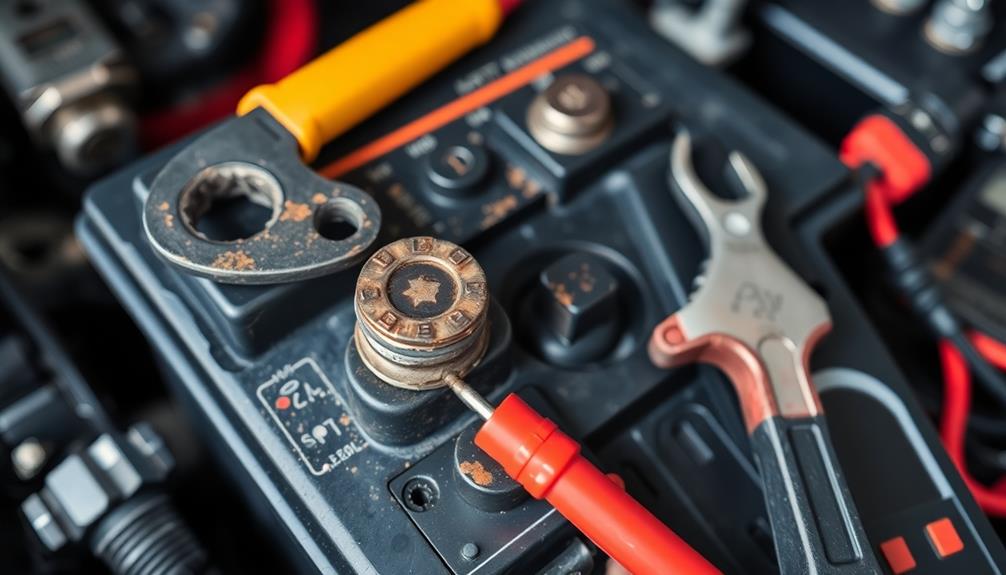
Your car's electrical system can encounter several common problems that may disrupt its performance. Recognizing these issues early can save you time and money.
Here are three prevalent car electrical problems to watch for:
- Dead Battery: This is the most common issue, often caused by age or leaving lights on. Signs include dim lights and trouble starting your engine, with replacement costs averaging $342-$352.
- Malfunctioning Alternator: A faulty alternator can lead to insufficient charging, dim lights, and stalling. If you experience these symptoms, be prepared for replacement costs ranging from $608 to $790.
- Blown Fuses: Blown fuses are protective measures that break circuits during overloads. Frequent blown fuses may indicate underlying problems like electrical shorts or loose wiring.
Other issues such as corroded battery cables can disrupt electrical flow, leading to starting problems.
Additionally, electrical shorts can create dangerous situations, often indicated by burning smells. If you notice any of these signs, it's essential to address them promptly to maintain your car's electrical system and guarantee safe driving.
Seeking Professional Help
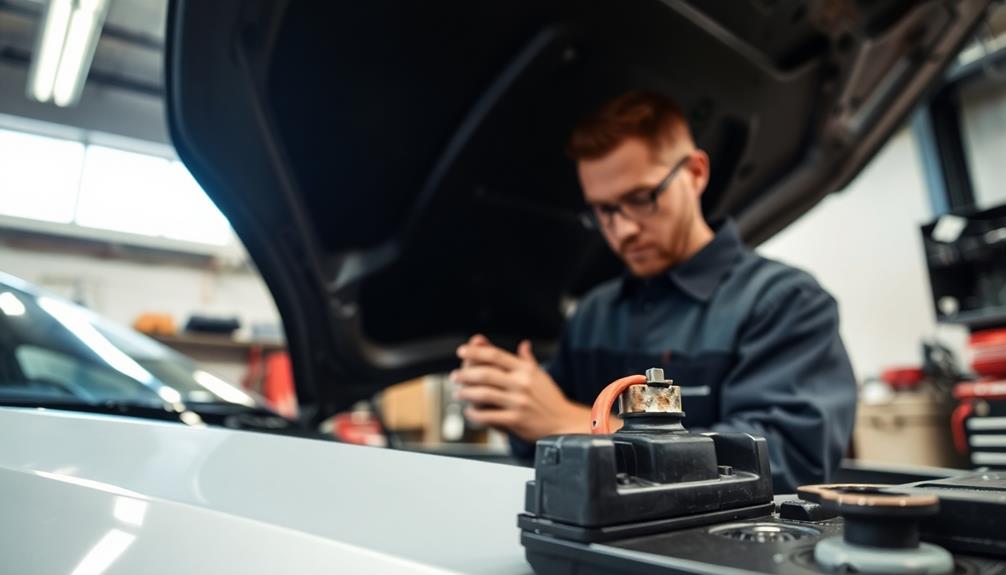
When electrical issues arise in your car, seeking professional help is often the best course of action. A certified mechanic can accurately diagnose and repair problems that might compromise your vehicle's safety and reliability.
Attempting to fix complex electrical problems on your own can lead to further complications, especially if you lack specialized diagnostic tools.
When you visit a professional auto repair shop, be sure to describe any symptoms you've noticed and detail any previous diagnostic steps you've taken. This information helps the mechanic understand the situation better, making the repair process more efficient.
Mechanics are equipped with the expertise to identify intricate electrical system failures that could be difficult to pinpoint through DIY methods.
Before any work begins, a reputable mechanic will provide you with a written estimate for repairs, allowing you to understand the costs involved.
Regular check-ups and inspections by professionals can also help catch potential electrical problems early, preventing costly breakdowns down the road.
Preventative Maintenance Tips
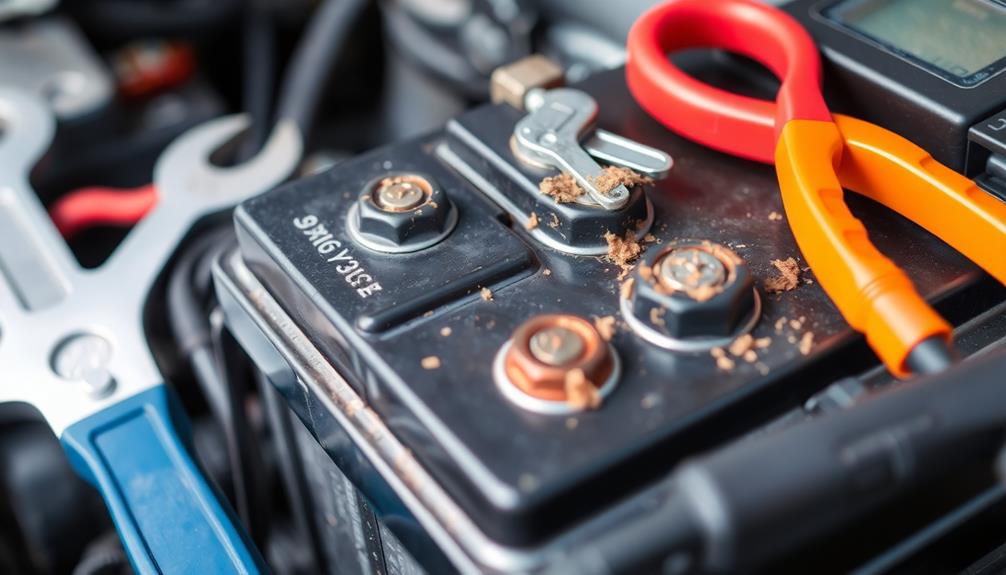
Regularly performing basic maintenance on your car's electrical system can prevent many common issues.
By taking a proactive approach, you can save yourself from costly repairs and guarantee your vehicle runs smoothly.
Here are three essential tips for effective preventative maintenance:
1. Check and Clean Battery Terminals: Inspect your battery terminals regularly to prevent corrosion, which can disrupt electrical flow and lead to starting problems.
A clean connection guarantees your battery performs efficiently.
2. Inspect Wiring and Connections: At least once a year, examine your car's wiring and connections for signs of wear or damage.
Catching potential issues early can prevent them from escalating into major problems.
3. Follow the Manufacturer's Maintenance Schedule: Adhere to your car's recommended maintenance schedule for electrical components.
This includes timely checks on the battery and alternator, as well as promptly replacing blown fuses with the correct rating to protect your circuits.
Frequently Asked Questions
How Do You Check Your Car's Electrical System?
To check your car's electrical system, inspect the battery terminals for corrosion, test battery and alternator voltage with a multimeter, check for blown fuses, and monitor dashboard warning lights for any issues.
How Much Does It Cost to Diagnose an Electrical Problem in a Car?
Diagnosing an electrical problem in your car typically costs between $100 and $150. Some shops might waive fees if you proceed with repairs, but complex issues could increase costs based on your vehicle's needs.
Can You Drive a Car With an Electrical Problem?
You shouldn't drive a car with an electrical problem. It can lead to unsafe conditions, like malfunctioning brakes or lights. Get any issues checked by a mechanic to avoid breakdowns and costly repairs.
What Is the Electrical System Warning on a Car?
The electrical system warning in your car indicates potential issues with the battery, alternator, or charging system. If you see this light, it's essential to investigate immediately to avoid further damage or safety risks.
Conclusion
Your car's electrical system is essential for its overall performance, so don't ignore signs of trouble. Have you checked your battery connections lately? A simple visual inspection can save you from bigger headaches down the road. If you notice any symptoms or aren't sure what to do, don't hesitate to seek professional help. By staying proactive and following preventative maintenance tips, you can keep your vehicle running smoothly and avoid unexpected issues.
